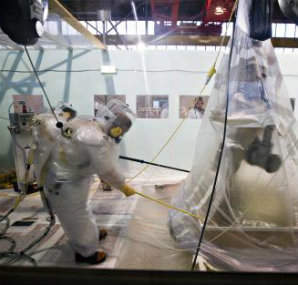
Dounreay’s highly active fuel examination cave is set to become the first structure on site to be removed using the Babcock Dounreay Partnership’s bulk approach to waste disposal.
The cave is part of the suite of buildings serving Dounreay’s first reactor, which is scheduled for demolition shortly.
After the highly active waste was removed and the structure of the cave was cleaned up remotely, a team of clean-up specialists decontaminated the area’s two 26-tonne maintenance area shield doors. The doors were then lifted through the building’s roof hatch by a mobile crane in June.
The work paves the way for the PIE cave to be dismantled as part of the final stages of clean-up of the active handling bay.
The concrete structure will be cut into large blocks using diamond wire cutting equipment, before being removed from the building and transported to a temporary waste store, pending final disposal in the new low level waste facility being constructed at the site.
The cave will be the first structure to demonstrate the Babcock Dounreay Partnership’s bulk approach to waste disposal.
This innovative approach to decommissioning will be used site wide on structures such as caves and cells. Babcock Dounreay Partnership intend to broaden the approach to include whole facilities, such as the Dounreay Materials Test Reactor.
Project Director for the FCA, Steve Beckitt, hailed the decommissioning of the PIE cave as a "significant achievement".
Photo: Winching x-ray equipment from the south cell of the Post Irradiation Examination caves back in 2009 (Source: DRSL – Chris Gregory)






